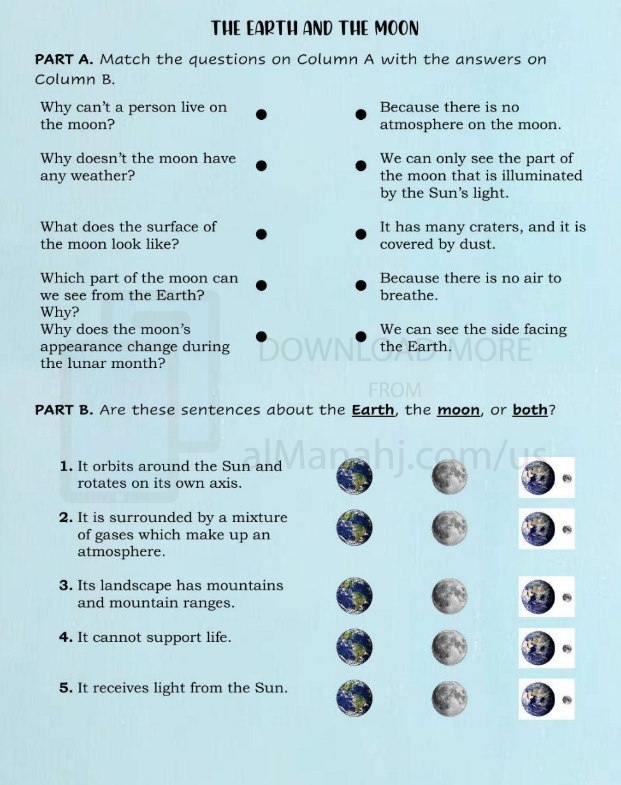| You are here: Almanahj Website ⇒ American curriculum ⇒ 6th Grade ⇒ Geology ⇒ Term 1 | ||
|---|---|---|
Worksheet about main features of the Earth and the moon | ||
|---|---|---|
| Subject: Geology | ||
| 6th Grade | ||
| Term 1 | ||
| Year: 2023/2024 | ||
| Size: 368.2KB | ||
| Number of clicks: 91 | ||
| Publish date:November 24, 2023 | ||
| Added by: Eman | ||
| Last download date: 2024-09-10 08:19:06 | By: theodor tcarolinarojas | |
| File info: The Earth and the Moon are celestial bodies that share some similarities but also have distinct features. Here are the main features of the Earth and the Moon: Earth: 1. Atmosphere: The Earth has a dense atmosphere primarily composed of nitrogen (78%) and oxygen (21%), along with trace amounts of other gases. The atmosphere plays a crucial role in regulating temperature, protecting against harmful radiation, and supporting life. 2. Hydrosphere: Earth is the only known planet with large bodies of liquid water on its surface. The presence of oceans, lakes, rivers, and groundwater is a defining feature of our planet. The hydrosphere supports diverse ecosystems and is essential for life as we know it. 3. Biosphere: Earth is teeming with life in various forms. The biosphere encompasses all living organisms, including plants, animals, and microorganisms. It includes diverse ecosystems, from lush forests to vast oceans, and provides habitats and resources for countless species. 4. Tectonic Activity: Earth is geologically active, characterized by plate tectonics. The lithosphere, which includes the Earth's crust and upper mantle, is divided into several large plates that move and interact with each other. This movement results in earthquakes, volcanic activity, the formation of mountains, and the recycling of Earth's crust. 5. Magnetic Field: Earth has a global magnetic field generated by the movement of molten iron in its outer core. The magnetic field protects the planet from harmful solar radiation and plays a crucial role in navigation for many organisms. Moon: 1. Surface: The Moon's surface is covered with craters, mountains, and plains. The most prominent features on the Moon's surface are impact craters formed by collisions with asteroids and comets. The lack of an atmosphere and erosion processes on the Moon means that many of these surface features remain preserved. 2. Regolith: The Moon's surface is covered by a layer of loose, fragmented material called regolith. It is composed of fine dust, small rocks, and larger boulders. The regolith is the result of billions of years of meteorite impacts breaking down the lunar surface. 3. Lack of Atmosphere: Unlike Earth, the Moon does not have a significant atmosphere. It has an extremely thin exosphere, which consists of sparse and scattered gas particles. The absence of an atmosphere means the Moon's surface is exposed to space and does not have protection from solar radiation or meteorite impacts. 4. Lunar Highlands and Maria: The Moon's surface is divided into two main regions: the lunar highlands and the lunar maria. The highlands are rugged, mountainous areas with numerous impact craters, while the maria are large, dark regions primarily composed of solidified basaltic lava flows from ancient volcanic activity. 5. Synchronous Rotation: The Moon is tidally locked to the Earth, which means it always shows the same face to us. This phenomenon is known as synchronous rotation. The side of the Moon facing away from Earth is referred to as the "far side" or "dark side" of the Moon, although it receives the same amount of sunlight as the near side. These are some of the main features that distinguish the Earth and the Moon. While Earth is a dynamic planet with a complex biosphere and diverse ecosystems, the Moon is a geologically inactive celestial body with a unique surface and lack of atmosphere. | ||
| Downloading link Worksheet about main features of the Earth and the moon |
|---|
|
1700813859.pdf
The file is being prepared for download
|
| File images |
|---|
 |